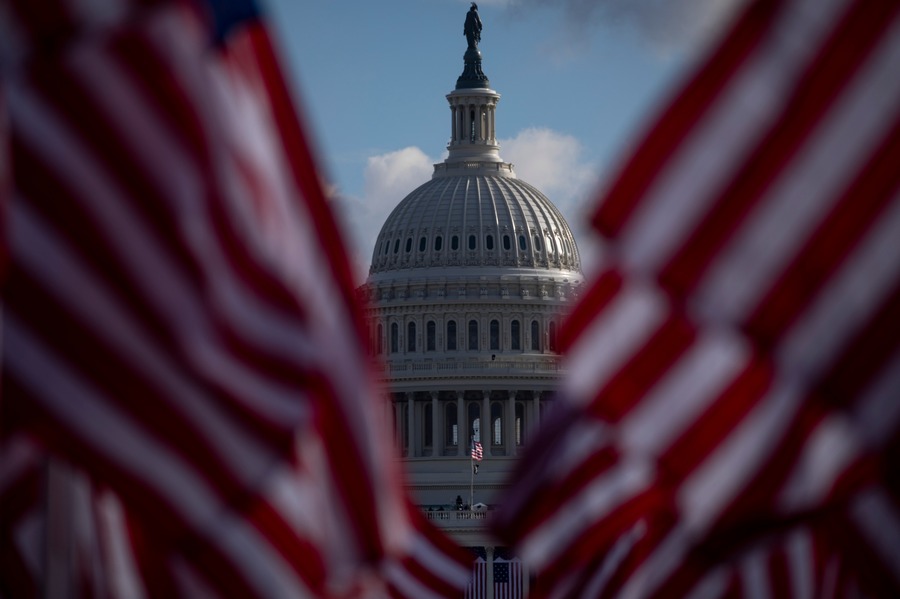How Congress Can Ensure CHIPS Act Funding Advances National Security Interests
As Congress moves towards conference consideration of major China-related legislation, funding for domestic semiconductor manufacturing will feature prominently.

Published by The Lawfare Institute
in Cooperation With

As Congress moves toward conference consideration of major China-related legislation, funding for domestic semiconductor manufacturing will feature prominently. And rightly so, as semiconductors, the brains of the modern world, support nearly every element of the 21st century economy. Given their importance, securing the United States’ supply of these chips is an economic and national security imperative. But as Congress leans into industrial policy, it has a responsibility to ensure that taxpayer dollars are spent strategically to advance U.S. interests, not amounting to a blank check untethered to U.S. strategic objectives. CHIPS Act investment must tilt the geopolitical scales strongly toward the U.S. side and, along with other proposals under consideration, advance U.S. leadership in the chips race vis-a-vis China.
The complex global distribution of the semiconductor value chain and the precipitous decline of semiconductor manufacturing capacity in the United States means that the United States is extremely vulnerable to supply shocks, as the recent shortages arising from pandemic and extreme weather events amply demonstrate. While geopolitical tensions have not yet been a driving factor in the supply chain disruptions, China’s intensifying ambition to indigenize its semiconductor sector and the extreme concentration of leading-edge chip production in Taiwan present significant security vulnerabilities. That’s where funding for domestic semiconductor manufacturing comes into play. Increased domestic production of chips is one important part of an overall strategy to mitigate these vulnerabilities.
Both the Senate’s United States Innovation and Competition Act (USICA) and the House’s America COMPETES Act include $52 billion in appropriations for the CHIPS Act that Congress authorized in the National Defense Authorization Act (NDAA) for Fiscal Year 2021. The NDAA authorization legislation and the House and Senate bills include important guardrails to prevent misuse, such as a prohibition on foreign adversaries from receiving CHIPS Act funds and general language to ensure that funding aligns with “economic and national security interests of the U.S.” But stronger policy direction is needed to ensure that the funding puts sufficient muscle behind the government’s efforts to achieve transformational changes in the chip supply chain.
Independent Assessment of Projected Chip Supply and Demand
First, Congress should require the Department of Commerce, or another qualified agency or independent entity, to expeditiously conduct an assessment of U.S. chips needs and projected global chip supply availability over the next five, 10 and 20 years. Prior government efforts provide a helpful snapshot of today’s needs, but a robust projection of future domestic needs and foreign availability—especially in allied countries—can ensure that CHIPS Act investments will help keep the United States ahead of future supply shocks. This sort of assessment would help the U.S. take stock of its needs for both bleeding- and leading-edge semiconductors—the more advanced chips that power things like supercomputers and advanced servers—as well as mature nodes of chips, which are critical to an array of technologies including automobiles and military technology. CHIPS Act investments will not alleviate today’s supply crunch, given the length of time it takes to build new fabs, the technologically complex and capital-intensive facilities that manufacture chips. But they can mitigate the risk of future shortages or supply disruptions, whatever the cause. This is especially true if they work in tandem with other initiatives in the legislation to build supply chain resiliency and bolster the government’s technology-forecasting capability.
Strategic Benefit Test
Second, Congress should establish a “strategic benefit” test for the expenditure of federal funds, which would assess whether the establishment or expansion of a fab would provide an overall strategic benefit to the United States. Commerce should be required to use this strategic benefit test when reviewing applications from semiconductor companies seeking to receive CHIPS Act incentives. Application of this test avoids the funding becoming a blank check and, instead, ties disbursement to a showing that it is a data-driven, strategic investment in the best interests of the United States.
The NDAA authorizations, as well as both funding bills under consideration in conference, include positive signals along these lines, including various forms of a requirement that CHIPS Act funding be distributed to projects that are in the economic or national security interests of the United States. Certain provisions include helpful guidance about policy objectives that Commerce should prioritize, such as enhancing the resiliency of supply chains, securing the supply of chips for national security applications, and promoting U.S. technological leadership. The various legislative components also recognize that a wide range of chip technology may be relevant for U.S. economic and national security objectives, ranging from cutting-edge technology that the United States must develop in order to maintain its global leadership role in the chip sector to mature technologies that underpin most electronic products. While these elements are all positive, Congress must solidify them into a unified set of instructions that Commerce can use to prioritize projects to receive CHIPS Act funding. The establishment of a strategic benefit test that incorporates and prioritizes the various policy objectives in the legislation and that is driven by an independent data assessment of projected chip supply and demand can provide this needed policy direction.
The strategic benefit test should prioritize investments in manufacturing capabilities that the United States must have domestically, either as a matter of ensuring global competitiveness and innovation leadership, or because there are use cases where production of some or all of a particular type of chip must be done in the U.S. to ensure security of supply.
For example, it may be in the best interest of the United States to use federal funds to support bleeding- or leading-edge chip production at certain nodes for certain end uses. This might be particularly the case where the U.S. is uniquely positioned to have an edge over competitors or adversaries or where the U.S. needs more investment to close a technological leadership gap. It might also be in the United States’ best interest to fund proposals aimed at increasing production capacity of more mature technologies that are still widely used in military or critical infrastructure applications, or even commodity technologies (for example, certain memory chips) that underpin most electronic products if projections show an anticipated gap in supply that could not otherwise be filled.
The strategic benefit test should account for the diversity and security of sources available globally for equivalent technology. Complete self-sufficiency is neither a realistic nor a necessary goal, and the strategic benefit test should account for the ability of the United States to securely access chips from allied nations. While the United States may want to ensure domestic production of certain chip technologies domestically, there will be a large range of technologies where a secure supply of chips from allied nations can meet U.S. national security needs just as well.
The flip side of relying on allied nations as critical partners in a secure, globalized chip value chain is that the United States should use CHIPS Act funding to encourage diversification away from adversary countries, notably China. A core part of the strategic benefit test should be to evaluate whether, on balance, the applying company is increasing its investments and level of manufacturing technology and capability in the United States vis-a-vis adversary nations. One of the strongest arguments for using incentives rather than relying on the free market is that this government engagement is a necessary defense against China’s industrial practices, which are increasingly at odds with a rules-based, liberal global order. CHIPS Act investments can be part of the response to this growing threat, but only if Commerce is directed to make funding decisions that take into account these strategic considerations.
To effectively implement a strategic benefit test, Congress should instruct Commerce to require applying companies to provide information on a confidential basis about the company’s current and planned operations in, and commercial relationships with, foreign adversaries. This includes whether the company is receiving any subsidies or preferential treatment from a foreign adversary. While not all activities may present a strategic threat warranting disqualification of an application, ensuring that Commerce has full visibility of these factors will be essential to ensuring that taxpayer dollars are not flowing to any company that is double-dipping in subsidies from a U.S. adversary or engaging in business dealings that risk leakage of U.S. technology and know-how.
Necessary Offset Evaluation
Third, Congress should establish a necessary offset evaluation, which would require Commerce to quantitatively assess the estimated amount of incentive needed to establish and sustainably operate a facility in the United States, provided that the facility meets the strategic benefit test. The U.S. share of global chip manufacturing capacity has declined for a variety of reasons, including lower labor costs in other countries, the industrial policies and incentive programs of other nations, and the emergence of competitive chip ecosystems, primarily in Asia.
An industry-supported report notes that establishing a fab in the United States costs approximately 30 percent more than in competing countries, with subsidies accounting for 40 to 70 percent of this difference. The necessary offset evaluation would independently test these numbers, taking into account intangible countervailing benefits available in the United States, such as strong rule-of-law and intellectual property protection. The ultimate goal of the assessment would be to develop an incentive number that accounts for both quantifiable and more intangible cost differential factors and that facilitates private-sector investment in semiconductor facilities or equipment in the United States on globally competitive terms.
The offset evaluation should account for any other incentives available to the applying companies, so that CHIPS Act funding complements rather than duplicates these additional pots of funds. The necessary offset evaluation results will show the amount of federal funding needed to boost the incentives otherwise available in order to facilitate the private-sector investment, while also setting an upper bound on CHIPS Act funding to avoid excessively large or wasteful incentives.
A necessary offset evaluation would put further rigor to requirements in the authorization bill that a funded fab not require government support over the long term. Companies applying for the CHIPS Act incentives must submit to Commerce an “executable plan to sustain the facility … without additional Federal financial assistance[.]” CHIPS Act investments are intended to be a boost that enables the establishment of more production capacity domestically, rather than a crutch that allows companies to operate on a noncommercial basis over the long term. Ensuring that investments are dedicated to projects that can compete without long-term government support will also allow the United States to make a clear distinction between its incentive programs, which are targeted and time limited, and the market-distorting effects created by China’s massive subsidization and state support of its chip sector.
Funding the CHIPS Act is a critical and necessary step toward greater resiliency in U.S. semiconductor supply chains. Congress must act to ensure that the implementation of the CHIPS Act lives up to its promise as a leading tool to advance U.S. national security interests.






